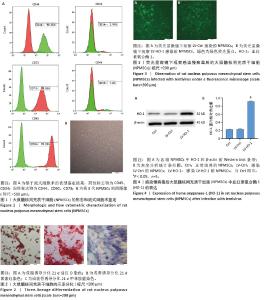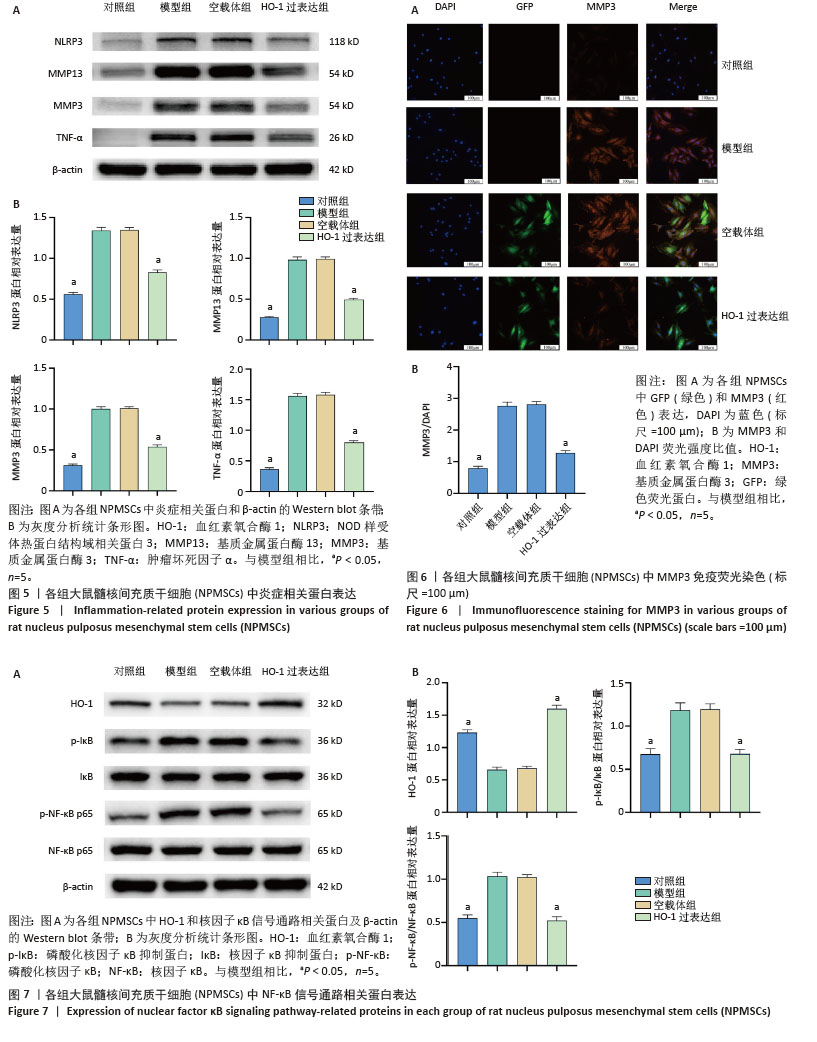Chinese Journal of Tissue Engineering Research ›› 2026, Vol. 30 ›› Issue (7): 1624-1631.doi: 10.12307/2026.589
Previous Articles Next Articles
Heme oxygenase-1 alleviates lipopolysaccharide-induced inflammatory response in nucleus pulposus mesenchymal stem cells
Cai Ziming1, Yu Qinghe2, Ma Pengfei2, Zhang Xin2, Zhou Longqian1, Zhang Chongyang1, Lin Wenping2
- 1Shenzhen Pingle Orthopedic Hospital Affiliated to Guangzhou University of Chinese Medicine, Shenzhen 518118, Guangdong Province, China; 2Department of Spine Surgery, Shenzhen Pingle Orthopedic Hospital Affiliated to Guangzhou University of Chinese Medicine, Shenzhen 518118, Guangdong Province, China
-
Received:2024-12-18Revised:2025-05-09Accepted:2025-05-29Online:2026-03-08Published:2025-08-18 -
Contact:Lin Wenping, MD, Chief physician, Doctoral supervisor, Department of Spine Surgery, Shenzhen Pingle Orthopedic Hospital Affiliated to Guangzhou University of Chinese Medicine, Shenzhen 518118, Guangdong Province, China -
About author:Cai Ziming, Master candidate, Shenzhen Pingle Orthopedic Hospital Affiliated to Guangzhou University of Chinese Medicine, Shenzhen 518118, Guangdong Province, China Yu Qinghe, MS, Physician, Department of Spine Surgery, Shenzhen Pingle Orthopedic Hospital Affiliated to Guangzhou University of Chinese Medicine, Shenzhen 518118, Guangdong Province, China Cai Ziming and Yu Qinghe contributed equally to this article. -
Supported by:National Natural Science Foundation of China, No. 81771323 (to LWP); Natural Science Foundation of Guangdong Province of China, No. 2021A1515010722 and No. 2024A1515010445 (to LWP); Natural Science Foundation of Shenzhen Municipality, No. JCYJ20190813112401660 (to LWP)
CLC Number:
Cite this article
Cai Ziming, Yu Qinghe, Ma Pengfei, Zhang Xin, Zhou Longqian, Zhang Chongyang, Lin Wenping. Heme oxygenase-1 alleviates lipopolysaccharide-induced inflammatory response in nucleus pulposus mesenchymal stem cells[J]. Chinese Journal of Tissue Engineering Research, 2026, 30(7): 1624-1631.
share this article
Add to citation manager EndNote|Reference Manager|ProCite|BibTeX|RefWorks

2.1 NPMSCs形态和流式鉴定结果 第3代NPMSCs在培养皿中贴壁生长,细胞排列紧凑,显示出强大的增殖能力,形态上呈现梭形或纺锤形。流式分析证实间充质干细胞符合鉴定标准:阳性标志物CD44(98.92%)、CD73(99.86%)、CD90(99.95%)阳性率均> 95%,阴性标志物CD34(2.99%)、CD45 (1.80%)表达量均< 5%,见图1。 2.2 NPMSCs三系分化鉴定结果 第3代NPMSCs分别经成脂、成骨、成软骨诱导分化培养基培养21 d后进行油红O、茜素红、甲苯胺蓝染色。油红O染色可见细胞内形成大量染红的脂滴,见图2A;茜素红染色可见大片红染的矿化结节,见图2B;甲苯胺蓝染色可见细胞呈蓝色,细胞周围出现蓝紫色异染颗粒,见图2C。 2.3 慢病毒感染效率 用LV-Ctrl和LV-HO-1感染NPMSCs,并采用2 μg/mL嘌呤霉素进一步筛选,在荧光显微镜下观察。经LV-Ctrl(图3A)和LV-HO-1(图3B)感染的NPMSCs均表达绿色荧光蛋白。提取第3代NPMSCs(对照组)、感染LV-Ctrl的NPMSCs、感染LV-HO-1的NPMSCs总蛋白,采用Western blot检测HO-1蛋白表达水平,结果显示感染LV-Ctrl的NPMSCs中HO-1蛋白表达与对照组无显著差异(P > 0.05),感染LV-HO-1的NPMSCs中HO-1蛋白表达较对照组显著提高(P < 0.05),见图4。 "


2.4 HO-1过表达对NPMSCs炎症相关蛋白的影响 与模型组相比,空载体组NPMSCs中NLRP3、基质金属蛋白酶13、基质金属蛋白酶3、肿瘤坏死因子α蛋白表达水平没有显著变化(P > 0.05),而HO-1过表达组NPMSCs中NLRP3、基质金属蛋白酶13、基质金属蛋白酶3、肿瘤坏死因子α蛋白表达水平均显著降低(P < 0.05),见图5。免疫荧光结果显示,与模型组相比,空载体组NPMSCs中基质金属蛋白酶3蛋白表达无显著差异(P > 0.05),而HO-1过表达组NPMSCs中基质金属蛋白酶3蛋白表达显著降低 (P < 0.05),见图6。上述结果表明,HO-1基因过表达对脂多糖诱导的炎症损伤具有缓解作用。 2.5 HO-1过表达对NPMSCs中核因子κB信号通路相关蛋白表达的影响 与模型组相比,对照组和HO-1过表达组HO-1蛋白表达显著升高(P < 0.05),而空载体组HO-1蛋白表达无显著差异(P > 0.05)。与模型组相比,HO-1过表达组磷酸化核因子κB/核因子κB的蛋白表达比值显著性降低(P < 0.05),磷酸化核因子κB抑制蛋白/核因子κB抑制蛋白的蛋白表达比值也显著降低(P < 0.05),见图7。 "

| [1]LI Q, GUO R, WU Z, et al. Endplate chondrocyte-derived exosomal miR-128-3p mitigates intervertebral disc degeneration by targeting TRAF6 via the miR-128-3p/TRAF6 axis to suppress pyroptosis. Int Immunopharmacol. 2024;143(Pt 3):113620. [2] ZHAO X, WANG Q, WANG S, et al. A novel multi-omics approach for identifying key genes in intervertebral disc degeneration. SLAS Technol. 2024;29(6):100223. [3] QIU C, CHENG L, DI D, et al. TNFα-reliant FSP1 up-regulation promotes intervertebral disc degeneration via caspase 3-dependent apoptosis. Genes Dis. 2025;12(1):101251. [4] HAN J, ZHANG J, ZHANG X, et al. Emerging role and function of Hippo-YAP/TAZ signaling pathway in musculoskeletal disorders. Stem Cell Res Ther. 2024;15(1):386. [5] XUE P, LV L, LIU L, et al. Unveiling the role of CXCL8/CXCR2 in intervertebral disc degeneration: A path to promising therapeutic strategies. J Orthop Translat. 2024;49:119-134. [6] MA S, XUE R, ZHU H, et al. Selenomethionine preconditioned mesenchymal stem cells derived extracellular vesicles exert enhanced therapeutic efficacy in intervertebral disc degeneration. Int Immunopharmacol. 2024;132:112028. [7] SAMANTA A, LUFKIN T, KRAUS P. Intervertebral disc degeneration-Current therapeutic options and challenges. Front Public Health. 2023; 11:1156749. [8] JIANG Z, CAO C, ZHANG Y, et al. Cell Reprogramming Strategies for Treating Osteoarthritis and Intervertebral Disc Degeneration. Aging Dis. 2024;16(1):5-12. [9] PENG Y, CHEN X, ZHANG Q, et al. Enzymatically Bioactive Nucleus Pulposus Matrix Hydrogel Microspheres for Exogenous Stem Cells Therapy and Endogenous Repair Strategy to Achieve Disc Regeneration. Adv Sci (Weinh). 2024;11(10):e2304761. [10] CUI P, SHENG Y, WU C, et al. Puerarin modulates proliferation, inflammation and ECM metabolism in human nucleus pulposus mesenchymal stem cells via the lncRNA LINC01535. Heliyon. 2024; 10(12):e33083. [11] REN J, XIN R, CUI X, et al. Quercetin relieves compression-induced cell death and lumbar disc degeneration by stabilizing HIF1A protein. Heliyon. 2024;10(17):e37349. [12] LV W, HU S, YANG F, et al. Heme oxygenase-1: potential therapeutic targets for periodontitis. PeerJ. 2024;12:e18237. [13] LEE I, YANG C, YANG C. Harnessing peroxisome proliferator-activated receptor γ agonists to induce Heme Oxygenase-1: a promising approach for pulmonary inflammatory disorders. Cell Commun Signal. 2024;22(1):125. [14] RYTER SW. Heme Oxygenase-1: An Anti-Inflammatory Effector in Cardiovascular, Lung, and Related Metabolic Disorders. Antioxidants (Basel). 2022;11(3):555. [15] ZHANG J, NI P, SONG Y, et al. Effective protective mechanisms of HO-1 in diabetic complications: a narrative review. Cell Death Discov. 2024;10(1):433. [16] XIANG Q, ZHAO Y, LIN J, et al. The Nrf2 antioxidant defense system in intervertebral disc degeneration: Molecular insights. Exp Mol Med. 2022;54(8):1067-1075. [17] XU G, LU X, LIU S, et al. MSC-Derived Exosomes Ameliorate Intervertebral Disc Degeneration By Regulating the Keap1/Nrf2 Axis. Stem Cell Rev Rep. 2023;19(7):2465-2480. [18] ZHANG Y, YANG S, QIU Z, et al. Pyrogallol enhances therapeutic effect of human umbilical cord mesenchymal stem cells against LPS-mediated inflammation and lung injury via activation of Nrf2/HO-1 signaling. Free Radic Biol Med. 2022;191:66-81. [19] LU S, LI M, CHENG Z, et al. HMGB1-mediated macrophage regulation of NF-κB activation and MMP3 upregulation in nucleus pulposus cells: A critical mechanism in the vicious cycle of intervertebral disc degeneration. Cell Signal. 2025;127:111628. [20] SHI M, ZHAO Y, SUN Y, et al. Therapeutic effect of co-culture of rat bone marrow mesenchymal stem cells and degenerated nucleus pulposus cells on intervertebral disc degeneration. Spine J. 2021;21(9):1567-1579. [21] PIZZICANNELLA J, FONTICOLI L, GUARNIERI S, et al. Antioxidant Ascorbic Acid Modulates NLRP3 Inflammasome in LPS-G Treated Oral Stem Cells through NFκB/Caspase-1/IL-1β Pathway. Antioxidants (Basel). 2021;10(5):797. [22] 于庆贺,蔡子鸣,田禾,等.芒柄花素抑制脂多糖诱导髓核间充质干细胞的炎症反应[J].中国组织工程研究,2025,29(25):5328-5334. [23] HUA W, XIE L, DONG C, et al. Procyanidin C1 ameliorates acidic pH stress induced nucleus pulposus degeneration through SIRT3/FOXO3-mediated mitochondrial dynamics. J Transl Med. 2024;22(1):1071. [24] WANG Y, ZHANG C, CHENG J, et al. Cutting-Edge Biomaterials in Intervertebral Disc Degeneration Tissue Engineering. Pharmaceutics. 2024;16(8):979. [25] CHIU A P, CHIA C, ARENDT-NIELSEN L, et al. Lumbar intervertebral disc degeneration in low back pain. Minerva Anestesiol. 2024;90(4): 330-338. [26] QIU X, ZHANG Y, WEI Z, et al. PLGA/BK microspheres targeting the bradykinin signaling pathway as a therapeutic strategy to delay intervertebral disc degeneration. Commun Biol. 2024;7(1):1540. [27] ZHANG X, GAO X, ZHANG X, et al. Revolutionizing Intervertebral Disc Regeneration: Advances and Future Directions in Three-Dimensional Bioprinting of Hydrogel Scaffolds. Int J Nanomedicine. 2024;19: 10661-10684. [28] WANG Z, QI L, HUANG Y, et al. Stem Cell Membrane-Camouflaged Biomimetic Nanoparticles Inhibiting Leptin Pathway for Intervertebral Disc Degeneration Therapy. ACS Appl Mater Interfaces. 2024;16(46): 63333-63344. [29] CONSONNI F M, INCERTI M, BERTOLOTTI M, et al. Heme catabolism and heme oxygenase-1-expressing myeloid cells in pathophysiology. Front Immunol. 2024;15:1433113. [30] CAMPBELL NK, FITZGERALD HK, DUNNE A. Regulation of inflammation by the antioxidant haem oxygenase 1. Nat Rev Immunol. 2021;21(7): 411-425. [31] HUANG C, ZOU K, WANG Y, et al. Esculetin Alleviates IL-1β-Evoked Nucleus Pulposus Cell Death, Extracellular Matrix Remodeling, and Inflammation by Activating Nrf2/HO-1/NF-kb. ACS Omega. 2024;9(1): 817-827. [32] TANG P, LIU B. Overactivation of NF-kB pathway can induce apoptosis by down-regulating glycolysis in human degenerative nucleus pulposus cells. Heliyon. 2024;10(17):e36905. [33] LI X, WU A, HAN C, et al. Bone marrow-derived mesenchymal stem cells in three-dimensional co-culture attenuate degeneration of nucleus pulposus cells. Aging (Albany NY). 2019;11(20):9167-9187. [34] CHENG S, LI X, JIA Z, et al. The inflammatory cytokine TNF-α regulates the biological behavior of rat nucleus pulposus mesenchymal stem cells through the NF-κB signaling pathway in vitro. J Cell Biochem. 2019;120(8):13664-13679. [35] LOU Y, SHI H, SHA N, et al. Ursodeoxycholic acid protects against sepsis-induced acute kidney injury by activating Nrf2/HO-1 and inhibiting NF-κB pathway. BMC Nephrol. 2025;26(1):45. [36] WANG P, ZHANG S, LIU W, et al. Bardoxolone methyl breaks the vicious cycle between M1 macrophages and senescent nucleus pulposus cells through the Nrf2/STING/NF-κB pathway. Int Immunopharmacol. 2024;127:111262. [37] CHEN S, HUANG Y, LEI L, et al. Daphnetin ameliorates intervertebral disc degeneration via the Keap1/Nrf2/NF-κB axis in vitro and in vivo. Int Immunopharmacol. 2025;145:113785. [38] ZHANG Y, HU Z, QI Y, et al. Pretreatment of nucleus pulposus mesenchymal stem cells with appropriate concentration of H(2)O(2) enhances their ability to treat intervertebral disc degeneration. Stem Cell Res Ther. 2022;13(1):340. |
| [1] | Xu Canli, He Wenxing, Wang Yuping, Ba Yinying, Chi Li, Wang Wenjuan, Wang Jiajia. Research context and trend of TBK1 in autoimmunity, signaling pathways, gene expression, tumor prevention and treatment [J]. Chinese Journal of Tissue Engineering Research, 2026, 30(在线): 1-11. |
| [2] | Yang Xuetao, Zhu Menghan, Zhang Chenxi, Sun Yimin, Ye Ling. Applications and limitations of antioxidant nanomaterials in oral cavity [J]. Chinese Journal of Tissue Engineering Research, 2026, 30(8): 2044-2053. |
| [3] | Guo Yuchao, Ni Qianwei, Yin Chen, Jigeer·Saiyilihan, Gao Zhan . Quaternized chitosan hemostatic materials: synthesis, mechanism, and application [J]. Chinese Journal of Tissue Engineering Research, 2026, 30(8): 2091-2100. |
| [4] | Fu Lyupeng, Yu Peng, Liang Guoyan, Chang Yunbing. Electroactive materials applied in spinal surgery [J]. Chinese Journal of Tissue Engineering Research, 2026, 30(8): 2113-2123. |
| [5] | Hu Xiongke, Liu Shaohua, Tan Qian, Liu Kun, Zhu Guanghui. Shikonin intervention with bone marrow mesenchymal stem cells improves microstructure of femur in aged mice [J]. Chinese Journal of Tissue Engineering Research, 2026, 30(7): 1609-1615. |
| [6] | Li Zhenyu, Zhang Siming, Bai Jiaxiang, Zhu Chen. Osthole improves osteogenic differentiation function of bone marrow mesenchymal stem cells under high-glucose conditions [J]. Chinese Journal of Tissue Engineering Research, 2026, 30(7): 1641-1648. |
| [7] | Zou Yulian, Chen Chaopei, Huang Haixia, Lan Yuyan, Liu Min, Huang Ting. Resveratrol promotes osteogenic differentiation of bone marrow mesenchymal stem cells in an inflammatory microenvironment [J]. Chinese Journal of Tissue Engineering Research, 2026, 30(7): 1669-1678. |
| [8] | Ding Yifan, Yin Wenjie, Zhang Li, Yuan Shuya, Sun Guoju, Zhang Naili, Zhao Dongmei, Ma Lina. Repair of segmental bone defect of rabbit radius by decalcified bone matrix loaded with adipose-derived stem cells [J]. Chinese Journal of Tissue Engineering Research, 2026, 30(7): 1679-1686. |
| [9] | He Jiale, Huang Xi, Dong Hongfei, Chen Lang, Zhong Fangyu, Li Xianhui. Acellular dermal matrix combined with adipose-derived stem cell exosomes promotes burn wound healing [J]. Chinese Journal of Tissue Engineering Research, 2026, 30(7): 1699-1710. |
| [10] | Xia Linfeng, Wang Lu, Long Qianfa, Tang Rongwu, Luo Haodong, Tang Yi, Zhong Jun, Liu Yang. Human umbilical cord mesenchymal stem cell-derived exosomes alleviate blood-brain barrier damage in mice with septic encephalopathy [J]. Chinese Journal of Tissue Engineering Research, 2026, 30(7): 1711-1719. |
| [11] | Cui Lianxu, Li Haomin, Xu Junrong, Tan Baodong, Lu Dahong, Peng Siwei, Wang Jinhui. Effect of umbilical cord mesenchymal stem cell conditioned medium on tissue repair after traumatic craniocerebral injury in miniature pigs [J]. Chinese Journal of Tissue Engineering Research, 2026, 30(7): 1730-1735. |
| [12] | Pan Dong, Yang Jialing, Tian Wei, Wang Dongji, Zhu Zheng, Ma Wenchao, Liu Na, Fu Changxi. Resistance exercise activates skeletal muscle satellite cells in aged rats: role of adiponectin receptor 1 pathway [J]. Chinese Journal of Tissue Engineering Research, 2026, 30(7): 1736-1746. |
| [13] | Chen Yulin, He Yingying, Hu Kai, Chen Zhifan, Nie Sha Meng Yanhui, Li Runzhen, Zhang Xiaoduo , Li Yuxi, Tang Yaoping. Effect and mechanism of exosome-like vesicles derived from Trichosanthes kirilowii Maxim. in preventing and treating atherosclerosis [J]. Chinese Journal of Tissue Engineering Research, 2026, 30(7): 1768-1781. |
| [14] | Tao Daiju, Su Haiyu, Wang Yuqi, Shen Zhiqiang, He Bo . Construction and identification of stable PC12 cell lines with high/low expression of miR-122-5p [J]. Chinese Journal of Tissue Engineering Research, 2026, 30(7): 1790-1799. |
| [15] | Liu Anting, Lu Jiangtao, Zhang Wenjie, He Ling, Tang Zongsheng, Chen Xiaoling. Regulation of AMP-activated protein kinase by platelet lysate inhibits cadmium-induced neuronal apoptosis [J]. Chinese Journal of Tissue Engineering Research, 2026, 30(7): 1800-1807. |
| Viewed | ||||||
|
Full text |
|
|||||
|
Abstract |
|
|||||